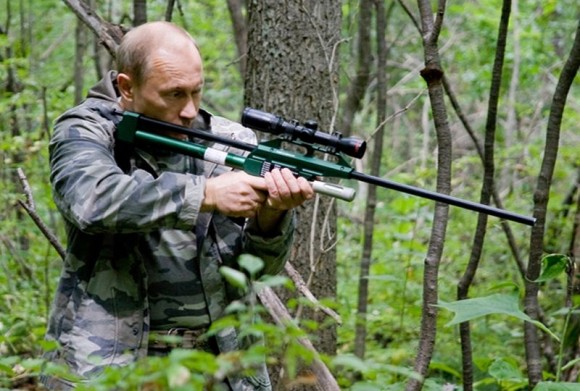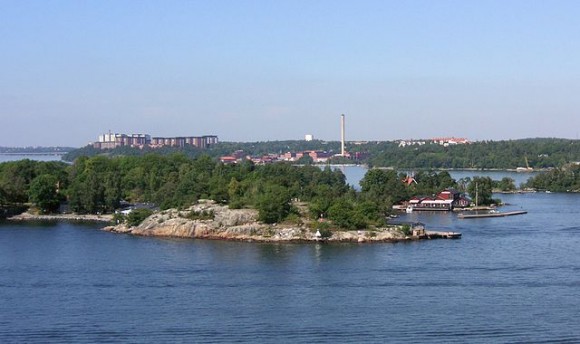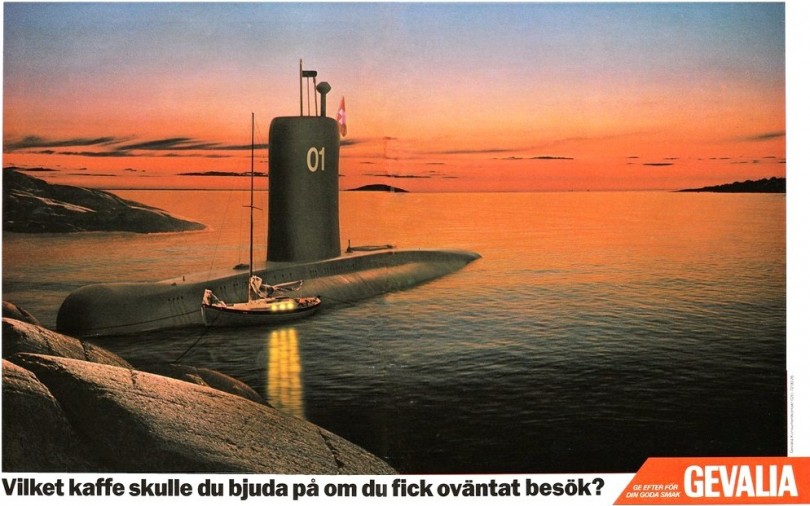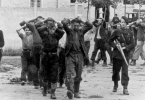
Wikimedia Commons
aNewDomain.net — Russian president Vladimir Putin has a soft spot for Cold War nostalgia, which probably plays well with his domestic political base. Russian submarine incursions into Swedish waters were a frequent and somewhat “hot” feature of the Cold War, which Putin seems to have relived this past week.
The Swedish navy spent the past week trying to find one, possibly two, foreign submarines, generally believed to be Russian, in the largest Swedish mobilization since the Cold War.
Unauthorized Russian Flight
On Thursday, a Russian spy plane was also intercepted over the Baltic twice by NATO jets. Danish F-16s assigned to NATO intercepted the plane before it crossed into Swedish airspace where it was met by Swedish warplanes. On its return, the plane crossed into Estonian airspace where it was met by Portuguese F-16s assigned to NATO.
Press reports curiously mentioned that the Russian plane was an Ilyushin IL-20, a wheeze bag of a plane developed in the late 1950s — imagine your great-granny trying to sneak up on you — but in its day, the plane was a workhorse of the Soviet air force.
Putin seems driven to restore the Tom Clancy worldview that dominated so much of the post war period. No one born after 1985 will remember the bursts of militaristic excitement mixed into the dough of the otherwise dreary Cold War years.
Many Americans over 45 likely share Putin’s nostalgia for the Cold War. After all, charity workers were not beheaded during the Cold War. Foreign agents didn’t conduct suicide missions in those years. By comparison to today, the Cold War almost seems harmless.
By probing Swedish territorial waters, the Soviet navy signaled its intentions to NATO during the Cold War. The operations also provided a venue for testing tactics, and occasionally involved sending commandos ashore. The Soviet operations ran from 1962-1988.
The most dangerous of these incidents occurred in 1981 when a Soviet submarine of the Whiskey class grounded itself on the Swedish coast. The incident, known as “Whiskey on the Rocks,” ended when a Swedish naval tugboat pulled the Soviet submarine off the coast into the waiting arms of a Soviet fleet that had been assembled in case the Swedes decided to seize the submarine.
Video: U 137 – Jägarförbandet (SVT, 1981)
The U-363 incident led to all kinds of parodies such as this one from Swedish coffee manufacturer Gevalia, which tastefully featured the flag of landlocked Switzerland on the submarine.

Image Credit: “Which coffee would you offer if you received unexpected visitors?” 1987 Gevalia ad
Russia has lost huge portions of its former empire since the end of the Cold War. Many of these countries have now joined NATO, and this past summer it appeared that the Ukraine had opted to shake off its 400-year-old ties to Russian and decidedly tilt towards the Europe Union.
It’s no surprise that Putin wants to relive the glory days of the Soviet empire.
In August, Putin boasted that he could capture the Ukrainian capital Kiev in less than two weeks. So, practicing an invasion of neutral Sweden sort of underlines the point, and sends a less than subtle message to all the other eastern European countries that have shaken off their ties to Russia after the end of the Cold War. Stockholm is, after all, 1500 miles away from Moscow — much farther away than Warsaw, Prague or Riga.
So, Putin has been working hard to return things to normal.
Sweden — the Perfect Venue for Field Testing Submarines
Sweden offers an ideal location for testing new weapons and telegraphing messages to rivals and potential enemies. The country provides an ideal location and geography for testing new weapons. Neutral Sweden also provides the perfect political geography for such maneuvers.
The Stockholm Archipelago
For submarines, the Stockholm Archipelago comprises more than 30,000 glacier-cut islands — deep waters dotted with clusters of islands. The archipelago extends eastward nearly 40 miles from Stockholm, a city itself comprised of islands, with an entrance nearly 100 miles wide. Sweden’s geography includes dozens of archipelagos, but the Stockholm Archipelago is also a major shipping lane.
The Stockholm Archipelago provides an excellent venue for testing new submarines and submarine tactics. Since neutral Sweden doesn’t anticipate an invasion, the visiting submarines sometimes need to signal their presence with a “distress” call. Such events ring a klaxon in Swedish naval headquarters which usually sends forces to find the submarines and encourage them to leave Swedish waters.

The Stockholm Archipelago
Swedish Neutrality
Sweden has not fought in a war since 1814. The country is known for maintaining an armed neutrality, and its laws forbid the country from joining military alliances. While Sweden is a member of the European Union, unlike Norway and Denmark, Sweden is not an official member of a defense organization like NATO. Of course, the revelations of Edward Snowden have called into question the depths of Swedish neutrality.
Nevertheless, if a foreign power were to send a submarine snooping around Scapa Flow, the British government might well order the royal navy to sink the vessel. If the foreign power threatened to retaliate, the NATO charter would oblige all 28 members of that alliance, including the United States, to come to Britain’s defense.
Sweden does not enjoy such mutual defense guarantees, although it did sign an agreement in September that places it closer to the NATO security blanket.
Thus, the Swedes have to think twice before sinking trespassing foreign vessels, especially if the vessel appears to be owned by a major power like Russia. For this reason, the Swedes have never attacked a foreign vessel directly — all depth charges have been dropped at a safe distance away from the intruder — close enough to send a message, far enough away to avoid harm.

HMS Visby, one of the Swedish boats searching for foreign submarines
Sweden’s Own Defense Industry
No Tom Clancy era Cold War discussion would be complete without a description of the military hardware involved, and non-aligned Sweden has developed some of the finest military weaponry around.
Wonder how a small Swedish patrol boat could dispatch a giant nuclear powered submarine — just watch this video and find out:
Video: Anti-submarine grenade launcher demo onboard Swedish Strike craft HMS Styrbjörn
Sweden itself has developed the world’s quietest submarine, which has apparently succeeded in military exercises with the US Navy in sinking some of its best ships, including our aircraft carriers:
Video: HMS Gotland on NBC Swedish Submarine (Swedish Subtitle)
One of the ships searching for the Russian sub was the HMS Visby. Here’s a video of the Visby in action:
Video: ADVANCED STEALTH Swedish Navy Visby Class Stealth Corvette
For aNewDomain.net, I’m Tom Ewing.
Based in the U.S. and Europe, Tom Ewing is an intellectual property strategist and attorney who advises the United Nations agency WIPO on patent issues, lawsuits and strategy. He also is a senior editor and a board member at aNewDomain.net.













